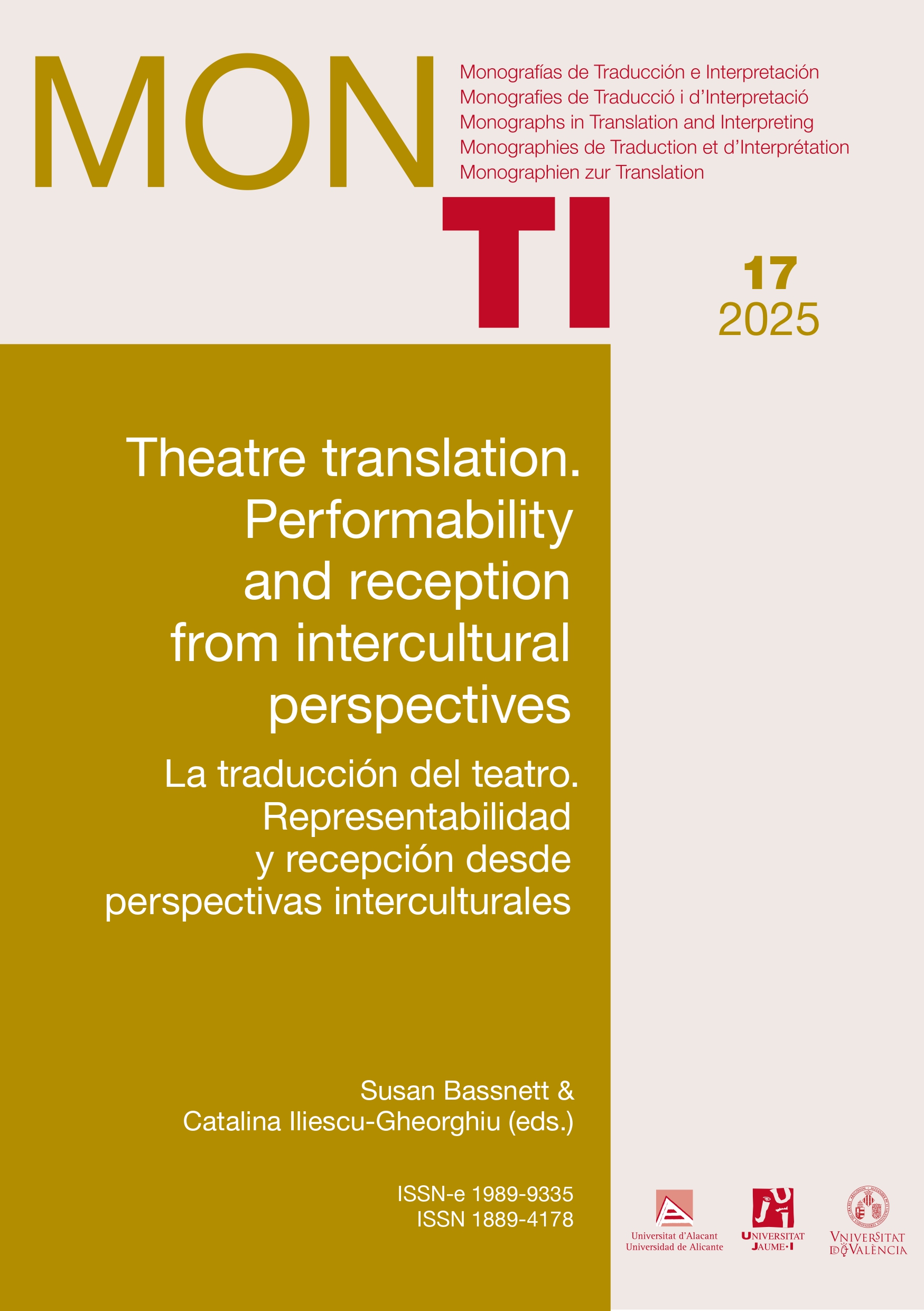La audiodescripción de danza: un análisis del proceso basado en entrevistas con profesionales
Main Article Content
Abstract
Dance audio description is a relatively recent modality that is still being developed to make choreographic works accessible to people with visual impairments or low vision. This study situates dance audio description within the broader field of audio description research and draws on the experiences of ten dance audio describers from different countries. Its purpose is to explore and provide a detailed account of the dance audio description process, to identify the main challenges, strategies, and supplementary resources employed, and to examine how practices diverge or align across different international contexts, with the ultimate aim of advancing accessibility and fostering a deeper understanding of this art form.
Downloads
Article Details

This work is licensed under a Creative Commons Attribution 4.0 International License.
The documents contained in these directories are included by the contributing authors as a means to ensure timely dissemination of scholarly and technical work on a non-commercial basis. It is understood that all persons copying this information will adhere to the terms and constraints invoked by each author's copyright. These works may not be reposted without the explicit permission of the copyright holder.
References
Benecke, Bernd (2004) “Audio-Description.” Meta 49, pp. 78-80. DOI: 10.7202/009022ar.
Bukowski, Sarah Cecilia (2021) “Hearing Dance: The Power of Audio Description.” Amy Seiwert’s imagery. Versión electrónica: <https://www.asimagery.org/sarahs-blog/2021/6/19/hearing-dance-the-power-of-audio-description>.
Cabeza-Cáceres, Cristóbal & Anna Matamala. (2008) “La audiodescripción de ópera: una nueva propuesta.” En: Pérez-Ugena y Coromina, Álvaro & Ricardo Vizcaíno-Pérez (eds.) 2008. Ulises y la comunidad sorda: Hacia el desarrollo de tecnologías comunicativas para la igualdad de oportunidades. Madrid: Observatorio de las Realidades Sociales y de la Comunicación, pp. 95-106.
Castan, Valérie (2014) L’audiodescription de spectacles chorégraphiques contemporains pour le public déficient visuel. París: Centre national de la danse.
Di Giovanni, Elena (2014) “Audio introduction meets audio description: an Italian experiment.” Special Issue: Across Screens Across Boundaries. inTRAlinea. Online translation journal. Versión electrónica: <https://www.intralinea.org/specials/article/2072>.
Fryer, Louise (2018a) “Unit 8: Dance and opera.” Transcripción del video principal. ADLAB Pro.
Fryer, Louise (2018b) “Staging the audio describer.” Disability Studies Quarterly, 38: 3. Versión electrónica: <https://dsq-sds.org/article/view/6490/5093>.
Fryer, Louise & Amelia Cavallo. (2022) Integrated Access in live performance. Nueva York: Routledge.
García Ruso, Herminia María (1998) “La danza. Propuesta de elementos a considerar en el estudio de la danza. Educación física e deporte no século XXI.” Congreso Internacional de Intervención en Conductas Motrices Significativas. A Coruña: Universidade, pp. 345-355.
Iturregui Gallardo, Gonzalo & Iris Cristina Permuy Hércules de Solás. (2019) “A template for the audio introduction of operas: A proposal.” Hikma 18:2, pp. 217-235.
Kleege, Georgina. (2014) “What does dance do, and who says so? Some thoughts on blind access to dance performance.” British Journal of Visual Impairment 32:1, pp. 7-13. DOI: 10.1177/0264619613512568.
Margolies, Eleanor. (2015) Going to hear a dance: On audio describing, Performance Research 20:6, pp. 17-23. DOI: 10.1080/13528165.2015.1111044.
Matamala, Ana. (2019) Accessibilitat i traducció audiovisual. Vic: Eumo Editorial.
Patiniotaki, Emmanuela. (2022) “Audio Description for Dance Performances: An Artistic and Collaborative Approach.” Status Quaestionis 23. DOI: 10.13133/2239-1983/18228.
Ramos Caro, Marina. (2024) “La audiodescripción de danza contemporánea: la importancia del símil en la transmisión del lenguaje visual abstracto.” En: Bottin, Béatrice (ed.) 2024. Las artes como expresión vital. Berna: Peter Lang. ISBN 978-3-631-91-588-2. SPI ICEE 350.
Romero-Fresco, Pablo. (2013) “Accessible filmmaking. Joining the dots between audiovisual translation, accessibility and filmmaking.” The Journal of Specialised Translation 20, pp. 201-223.
Rojo López, Ana. (2013) Diseños y métodos de investigación en traducción. Madrid: Síntesis.
Snyder, Joel. (2010) “AD guidelines and best practices (version 3.1.).” American Council of the blind’s audio description project. Versión electrónica: < https://adp.acb.org/docs/AD-ACB-ADP%20Guidelines%203.1.doc>.
Snyder, Joel & Esther Geiger. (2022) “Opera and dance audio description.” En: Taylor, Christopher & Elisa Perego (eds.) 2022. The Routledge Handbook of Audio Description, pp. 168-182. New York: Routledge.
Udo, John-Patrick & Deborah Fels. (2010) “Enhancing the Entertainment Experience of Blind and Low-vision Theatre-goers Through Touch Tours.” Disability and Society 25: 2, pp. 231-240, pp. 168-182.
Varios autores (AENOR). (2005) UNE 153020:2005. Audiodescripción para personas con discapacidad visual. Requisitos para la audiodescripción y elaboración de audioguías. Madrid: AENOR – Asociación Española de Normalización y Certificación.
Verdú Macián, Alicia. (2022) Accesibilidad en la danza mediante la audiodescripción: la traducción Intersemiótica como recurso para las personas ciegas y con baja visión. Trabajo final de grado inédito. Universidad de Valencia.


